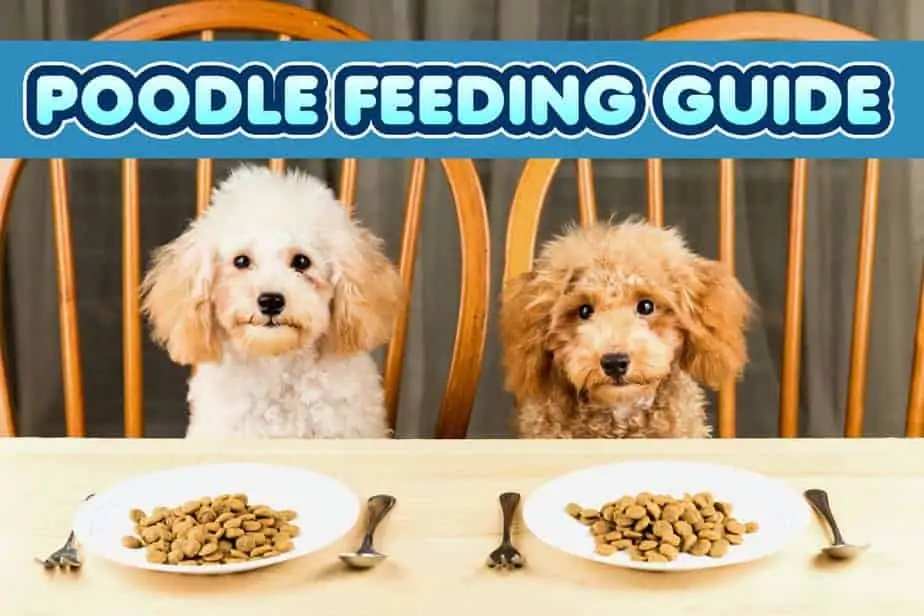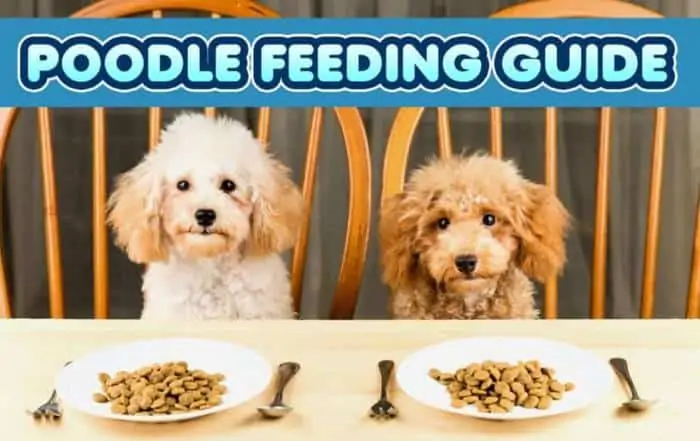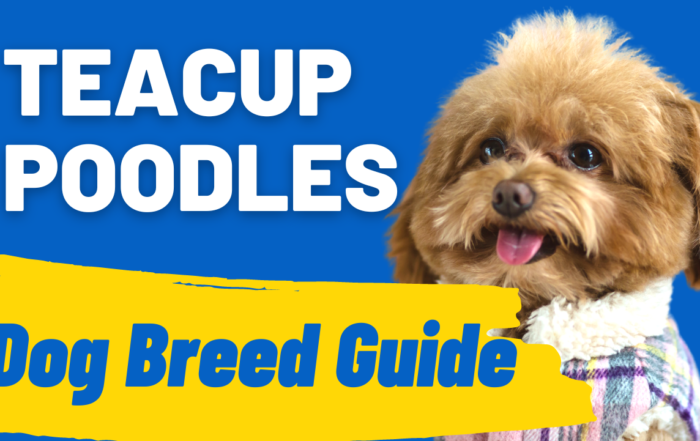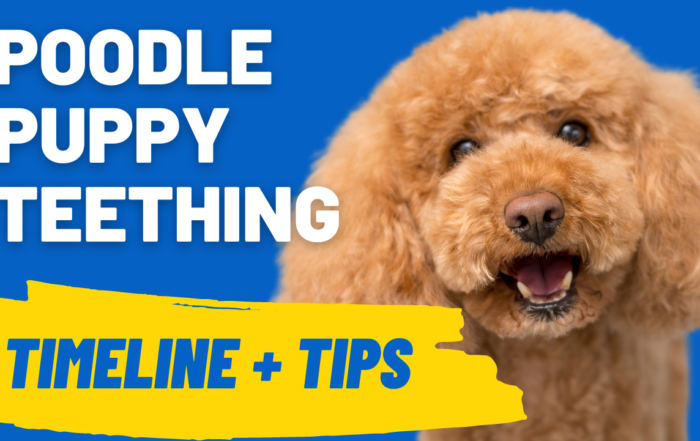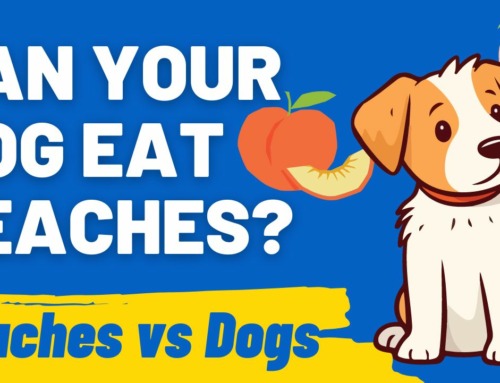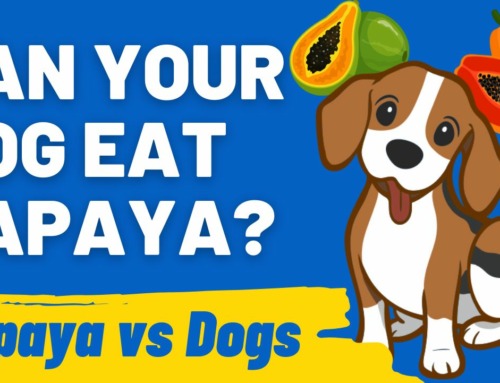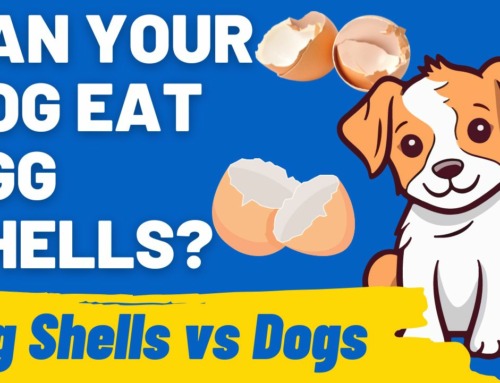There’s much to learn when it comes to feeding your Poodle. Things like what food they should eat, how much they should eat, and what human foods should be avoided.
We’ve simplified things with some easy to read tables with some popular puppy food brands and broken everything down into the three size categories of Toy, Miniature, or Standard.
This way you can match the information that suits your Poodle breed.
We also give you the formula so you can calculate your own requirements if your food of choice isn’t listed.

How to Determine How Much to Feed a Poodle Puppy
The first step in determining how much your Poodle puppy should be fed is to determine how many food calories (also called kcals) your puppy needs in order to grow properly.
We’ve worked out the calculations for you for each size poodle. If you want to go straight to your size, use the table of contents to select your poodle size chart.
However, it’s a good idea to understand how we arrived at those calculations so you can adjust as necessary in the future. It sounds more complicated than it is!
Also understanding the formula will mean you can do your own calculations with the food you buy if it’s not on our list of chosen brands.
*EDIT – We have great news; our dog feeding calculator is now LIVE. Not only that, but it works perfectly for all poodle sizes. You can now use it here: Dog Feeding Calculator.
The Feeding Calculation Formula for your Poodle (All Sizes)
The Resting Energy Requirement, also known as the RER, is simply based upon body weight and what an animal needs in energy at complete rest, (without considering growth, health, or exercise).
For example, according to Hills Vet, the average Resting Energy Requirement for a 1lb dog is 39 kcal/day.
This Resting Energy Requirement can then be used to find the Daily Energy Requirement, or what your individual dog needs based upon their age, growth, and lifestyle. Lifestyle will be determined by you as the owner, knowing how active your dog is.
- Puppies that are under 4-months old need 3x the normal RER (due to rapid growth)
- Puppies that are 4-months to adulthood require 2x the average RER.
(Attained from https://vet.osu.edu/vmc/companion/our-services/nutrition-support-service/basic-calorie-calculator)
If the dog is going through heavy exercise, or raising puppies, they may need 2-8 times the Resting Energy Requirement to satisfy their Daily Energy Requirement needs.
Therefore, a 1lb Poodle puppy requires 3X their RER of 39 kcal/day, which equates to 117kcal/day. You would then look at their food bag and check how many kcals are in a cup. As they are a puppy and may have 3 meals a day, you would divide the 117kcals by how many meals.
Sounds a little complicated but we break it down in the charts below.
Here are the Resting Energy Requirements for weight ranges in lbs that cover Toy, Miniature, and Standard puppy weights.
| Lbs | RER (kcal/day) |
|---|---|
| 1 | 39 |
| 2 | 65 |
| 3 | 88 |
| 4 | 110 |
| 5 | 130 |
| 6 | 149 |
| 7 | 167 |
| 8 | 184 |
| 9 | 201 |
| 10 | 218 |
| 11 | 234 |
| 12 | 250 |
| 13 | 265 |
| 14 | 280 |
| 15 | 295 |
| 16 | 310 |
| 17 | 324 |
| 18 | 339 |
| 19 | 353 |
| 20 | 366 |
| 25 | 433 |
| 30 | 497 |
| 35 | 558 |
For more weights (or to see them in kg’s), use this chart here: https://wilmotveterinaryclinic.com/wp-content/uploads/2016/10/Resting-Energy-Requirements.pdf

If you want to learn more about Teacup Poodles, we have this great post on them, Teacup Poodles: Your Questions Answered.
Simplifying the Calculation
Use the following steps to workout how much to feed your Poodle – Toy, Miniature, or Standard doesn’t matter, it’s their weight that is used:
- Weigh your poodle
- Is your poodle under 4-months old?
- If they are under 4-months, you will need to triple their RER (found in the above table).
- If they are over 4-months old to 1-year, you will need to double their RER.
- If they are a full-grown adult, you will need to 1 – 1.6x their RER.
- If your dog spends all day running, then you will need to increase their final Daily Energy Requirement to suit their needs.
- So, for an example, if your poodle is 8-weeks-old and weighs 1lb, their RER is 39 kcals/day x3 = 117kcals/day
- Now you have their required kcals per day (117 in the example), you then look at the back of your packet of chosen puppy/adult food and look at kcals per cup.
- If you’re using Purina Pro Plan Puppy for example, each cup is 456 kcals.
- Now get your calculator and divide 117kcals (from the example) by 456 (how much is in a cup).
- The answer is 1/4 cup per day. Voila!
If you’re interested in your Poodle’s size, read our post: Your Poodle Size Guide: Toy, Mini, Standard
Or this might also interest you: 27 Foods Poodles Can and Can’t Eat: Fruits, Vegetables, Meats, Nuts

Toy Poodle Feeding Requirements Chart
This table was calculated using the average weights at each age for a Toy Poodle, and the Resting Energy Requirements and Daily Energy Requirements necessary according to Hills Vet.
We chose four of the most highly recommended puppy food brands to calculate the required amounts.
(You can click on any of them to purchase from Chewy, who offers a 30% saving on Autoship to new customers, which you can set up so you never have to worry about buying your dog food again!)
| Weight (lbs) | Age (months) | Daily kcal requirement | Purina Pro Plan Puppy | Taste of the Wild Puppy | Hill’s Science Diet Puppy | Blue Buffalo Puppy |
|---|---|---|---|---|---|---|
| 1 | 2 | 117 kcal/day | 1/4 cup/day | 1/3 cup/day | 1/3 cup/day | Between 1/4 and 1/3 cup/day |
| 3 | 4 | 176 kcal/day | 1/3 cup/day | 1/2 cup/day | 1/2 cup/day | Between 1/3 and 1/2 cup/day |
| 5 | 12 | 208 kcal/day | 1/2 cup/day | Slightly over 1/2 cup/day | Slightly over 1/2 cup/day | 1/2 cup/day |
Please note: this table is a recommended starting place when determining how much food your Toy Poodle needs.
You should follow additional veterinary guidance as well as the actual body condition of your Toy Poodle to determine if they need more or less kcal/day.
How Much to Feed a Miniature Poodle Puppy
As with the Toy Poodle, we’ll calculate how many kcal/day are necessary for their growth, and determine how much puppy food they need on average. For an 8-week-old Miniature Poodle weighing 3lbs, they should be eating a 1/2 cup of food each day if feeding with the Purina Pro Plan puppy food we are using in this example.
As we did previously, the calculations are as follows:
- Determine the Resting Energy Requirements for a 3lb dog.
- 88 kcal/day, according to Hills Vet
- Calculate the Daily Energy Requirements for an 8-week-old dog.
- Dogs under 4-months need 3 times the RER – so in this case, 3 times 88 is 264 calories/day.
- Calculate how much food is necessary to equal 264 kcals/day when the food contains 456 kcals/cup.
- 264 divided by 456 equals 0.58, or slightly more than half a cup of food.
We’ve calculated the rest of the average requirements to feed your Miniature Poodle puppy over the first year of their life in the below table.
Miniature Poodle Feeding Requirements Chart
This table was calculated using the average weights at each age for a Miniature Poodle, and the Resting Energy Requirements and Daily Energy Requirements necessary according to Hills Vet, as well as the average kcal content in each cup of Purina Pro Plan Focus Puppy: Chicken and Rice formula.
| Weight (lbs) | Age (months) | Daily kcal requirement | Purina Pro Plan Puppy | Taste of the Wild Puppy | Hill’s Science Diet Puppy | Blue Buffalo Puppy |
|---|---|---|---|---|---|---|
| 3 lbs | 2 months | 264 kcal/day | 1/2 cup/day | Slightly under 3/4 cup/day | Slightly under 3/4 cup/day | 2/3 cup/day |
| 6 lbs | 4 months | 298 kcal/day | 2/3 cup/day | Slightly over 3/4 cup/day | Slightly over 3/4 cup/day | 3/4 cup/day |
| 12 lbs | 12 months | 400 kcal/day | 7/8 cup/day | Slightly over 1 cup/day | Slightly over 1 cup/day | 1 cup/day |
As before, use this chart as a starting point and always feed your Miniature Poodle based on their individual needs, their body condition, and veterinary recommendation.

How Much to Feed a Standard Poodle Puppy
We’ll once again calculate how many kcal/day are necessary for their growth, and determine how much puppy food they need on average – this time, for a Standard Poodle.
For an 8-week-old Standard Poodle weighing 8lbs, they need about 1 and 1/4 cups of the Puppy Purina Pro Plan we’ve been using as an example.
The calculations to get this number are shown below:
- Determine the Resting Energy Requirements for an 8lb dog.
- 184 kcal/day, according to Hills Vet
- Calculate the Daily Energy Requirements for an 8 week old dog.
- Dogs under 4-months need 3 times the RER – so in this case, 3 times 184 is 552 calories/day.
- Calculate how much food is necessary to equal 552 kcals/day when the food contains 456 kcals/cup.
- 552 divided by 456 equals 1.21, or roughly 1 and 1/4 cups of food.
As we’ve done previously, the average amount of food necessary for a Standard Poodle over their first year of life is included in a chart below.
Standard Poodle Feeding Requirements Chart
This table was calculated using the average weights at each age for a Standard Poodle, and the Resting Energy Requirements and Daily Energy Requirements necessary according to Hills Vet, as well as the average kcal content in each cup of Purina Pro Plan Focus Puppy: Chicken and Rice formula.
| Weight (lbs) | Age (months) | Daily kcal requirement | Purina Pro Plan Puppy | Taste of the Wild Puppy | Hill’s Science Diet Puppy | Blue Buffalo Puppy |
|---|---|---|---|---|---|---|
| 8 lbs | 2 months | 552 kcal/day | 1 and 1/4 cups/day | 1 and 1/2 cups/day | 1 and 1/2 cups/day | 1 and 1/3 cups/day |
| 25 lbs | 4 months | 866 kcal/day | 1 and 7/8 cups/day | 2 and 1/3 cups/day | 2 and 1/3 cups/day | Slightly over 2 cups/day |
| 55 lbs | 12 months | 1253 kcal/day | 2 and 2/3 cups/day | Slightly under 3 1/2 cups/day | 3 and 1/3 cups/day | Slightly over 3 cups/day |
Summary of charts
As you can see from these examples, the age, weight, and health of your Poodle makes a big difference in how much food they should be eating.
It’s also good to note that the recommended feeding amounts on the back of the bag of puppy foods are only estimations.
For this reason, it’s always a good idea to feed your Poodle puppy the amount of food that keeps them healthy, rather than relying too hard on any specific number.
You’ll want to make sure your Poodle remains in good health and maintains a good weight, and whatever amount of food serves that purpose is the right amount for them!
One final note: the kcal/cup are often less in foods formulated for adult dogs than those formulated for puppies.
As you switch your puppy to adult dog food, you’ll likely need to feed them a different amount.
For example, the Purina Pro Plan Adult Savor: Complete Essentials Shredded Blend of Lamb and Rice, only has 350 kcal/cup.
Check the back of the Adult bag of dog food for the kcal/cup so you can calculate the required amount.
The puppy version contains 456 kcal/cup.
You’ll need to feed your adult Poodle more of the adult version of a food than the puppy version in order for them to eat the same amount of calories.
If you want to find something your dog will love and spend time doing, then we think our puzzle toy blocks are about the best dog toys on the market. Of course we’d say that though, so see them for yourself on Amazon!
You also might like to read our post, The 20 Best Dog Enrichment Toys

Best Food to Feed a Poodle (Toy, Miniature, Standard)
The best food to feed your Poodle is the food that they do best on. It may seem like a cliché, but it’s true! Not all dogs do best on the same foods.
However, there are a few general guidelines you should follow when choosing a food for your Poodle.
Ideally, the food you choose to feed your Poodle should be carefully tested to ensure it provides all the nutrients that your Poodle puppy needs.
The first place to look for this is to see if the food meets AAFCO (Association of American Feed Control Officials) guidelines. These are a voluntary set of models to follow when testing dog food, and any food you choose to feed your Poodle should strive to voluntarily go through this process.
This label often appears on a bag of dog food as a statement from AAFCO saying “this product provides complete and balanced nutrition” or “this product is formulated to meet the nutritional levels established by the AAFCO Dog Food Nutrient Profiles.”
Here are the listed brands we used for our charts, which are all high-quality puppy foods.
There’s also plenty of misconceptions regarding byproducts and grains. The reality, according to many veterinarians, is that byproducts and grains can absolutely be a part of a healthy dog food.
Byproducts are simply parts of an animal carcass, such as bones and organs. While this might not sound appealing to us humans, bones and organs are an essential part of a dog’s diet.
If you choose a food manufactured under AAFCO standards, these byproducts will only include the parts that are healthy and good for our dogs, and not any hair, teeth, hooves, or other parts you’ve likely heard horror stories about ending up in dog food.
In fact, even dogs that are fed “raw food” where their owners compile parts of animals to feed whole and raw to their dogs must be fed a correct proportion of bone and organs or they will become deathly ill.
It’s also the case that grains are often not a common allergy in dogs. More dogs are allergic to chicken than to grains!
Recent studies have also shown that foods that are “grain free” may contribute to higher risks of heart conditions.
Before determining that grain-free is best for your dog, it’s important to talk through the risks with your pet’s veterinarian and determine if there are truly grain allergies present in your dog.
Following these requirements still leaves plenty of options to find one that is best for your dog and your budget. In fact, the most expensive food is rarely the best choice for your individual dog.
My personal dogs love Purina ProPlan and do very well on it!
Another option is to use a fresh food service like PetPlate, which provides human-grade nutrient-rich meals and the correct daily requirements (all worked out for you). We have a write-up on their service here so you can see if they’re a good fit for your poodle.
But my Poodle is a Picky Eater!
If you have a picky eater, you may need to try several of these options for food before you find one that your dog loves the most. In general, Royal Canin has been reported to be loved by many picky eaters in the world.
You may need to try different flavors, as well as different brands.
It’s also a good idea to see your dog’s veterinarian if you notice that they are refusing to eat, because there may be a medical problem that should be addressed.
You’ll want to avoid encouraging a picky eater to eat by adding gravy, cheese, or other toppings to entice them.
While it may work in the moment, it sets your dog up to only be pickier in the future.
Should I Feed Kibble or Wet Food?
Kibble is usually going to be more cost effective than feeding wet food, and has its own health benefits as well.
Dogs that eat exclusively wet food often have poorer dental health, due to not eating something that they can crunch and help clean their teeth.
However, wet food is certainly an option if you prefer it. You’ll just have to pay extra attention to their dental health, as well as set aside a larger budget for dog food each month.
There’s also the possibility that the softer food will make for softer stools. Which can sometimes lead to full anal glands, because the hard stools aren’t expressing them.
I compromise with my own dogs by feeding kibble on a daily basis, and using wet food to fill their Kongs and other stuffable toys before putting them in the freezer.
This way, they still get the occasional delicious and new taste of wet food, without having to only feed wet food exclusively.
Note: While it’s not usually a problem in puppies, a dog that has already had poor dental health in their life may do better eating wet food in the future, especially if they have had their teeth pulled.
What About Human Food?
We’ll wrap up this article on feeding your Poodle by talking about the human foods that your Poodle can (and can’t) eat.
Besides consulting these lists, it’s also a good idea to make sure you add any treats or human food snacks into your dog’s daily caloric requirements.
If you feed too many treats, your Poodle is likely to gain weight and become obese. This will lead to many health problems down the road, so it’s best to keep your dog slim and healthy.
Bully sticks are a trap for dog owners as it’s difficult to know how many calories they have in them. You might like to read our post Are Bully Sticks Safe For Puppies? (Answered)
Human Foods My Poodle Can Eat
In moderation, and without allergies, the following foods are often safe to feed your Poodle – especially if you use them as a high-value training treat:
- Peanut Butter
- Apples
- Applesauce
- Plain Yogurt
- Carrots
- Lunch Meat
- Hot Dogs
- Cheese
Human Foods My Poodle Cannot Eat
These foods are always dangerous and you should avoid them when sharing a snack with your Poodle:
- Caffeine
- Coffee
- Macadamia Nuts
- Chocolate
- Grapes
- Raisins
- Onions
- Garlic
- Xylitol
Final Word
Hopefully you now have a good grasp on how much you should be feeding your Poodle, whether they’re Toy, Miniature, or Standard in size.
If you feel you’re still a bit lost, or that your dog isn’t happy with their diet in anyway, it’s best to consult your Veterinarian. They can offer advice, and check that your dog doesn’t have any other issues that could be affecting their appetite or weight.
You might also like to read our post: Can You Overfeed Your Puppy? (Yes or No)

